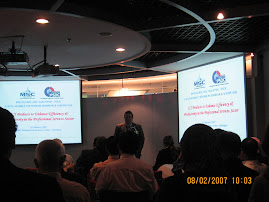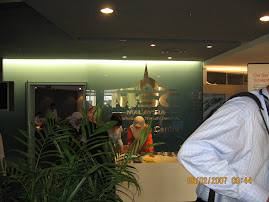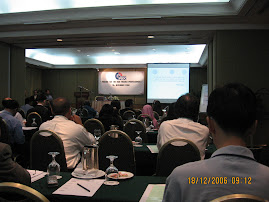Co-Agency Dispute: P vs. D (Part 5)
(Continuing from Part 4 of this post...)
In Para 1 of P's Statement of Claim, P claims for the first time that she was also known as Sharon DM in the practice of estate agency. Before she filed her Summons & Statement of Claim:
* she and her lawyers never even once claimed so;
* not a single document in which Sharon DM appeared for P's firm states that Sharon DM is also P;
* not a single document in which P appeared for P's firm states that P is also Sharon DM;
* when P appeared for the first time in the letter dated 3.7.2006, P refers to the earlier letter dated
3.1.2005 (Exhibit P15) in which Sharon DM appeared for P's firm as "our letter" and not "my letter";
* all the documents show that Sharon DM's designation is the Resident Manager while P's designation is the Principal and not a single document states that the Resident Manager is also the Principal;
* all the documents show that Sharon DM's signature is totally and consistently different from P's signature.
When P took to the Witness Stand in the year 2010, P went on to claim, also for the first time, in A18 of her Witness Statement that P's designation was also "Resident Manager E1236" (apart from being the "Principal"). Interesting, isn't?
Had the loosely-attached operatives of P's firm, say, run away with client's or customer's money; or, had P's firm been sued for a civil wrong, say, due to a misrepresentation or trespass by P's operatives, or investigated for offences (say, licence-leasing), would P be forthcoming to say that Sharon DM was also her? The designation of Resident Manager was also P's designation? And, that Sharon DM's different signature was also P's signature? On balance of probabilities, would P?
P obviously had her reasons not to allow her operatives like M and others to use her real and official name to practise estate agency. The use of the name Sharon DM (instead of P's official name) with the designation Resident Manager (instead of Principal) and a different signature was clearly calculated to allow P to disown responsibilities / liabilities in the event of civil suits and/or investigated for offences. And the use of E1236 (now known to be P's personal registration number with the Lembaga) beside the designation Resident Manager was a devious ploy calculated to enable her to claim that Sharon DM was also her when she needs to claim for fee such as in this suit: Head, she wins; tail, D and the public lose, so she thinks.
Most practitioners can vouch that by market practice, the designation of Resident Manager is for an employee-REA employed by an estate agency to run the agency and/or its branches and not a designation for the boss of the agency. Take Wang Lai Realty (sole-proprietorship) as a classic example: Aren't its Resident Managers the employee-Registered Estate Agents employed by it (the sole-proprietorship) to run the agency and its branches? And, the Resident Managers are not the Principal nor the sole-proprietor nor the boss of the agency (who is a Mr. James Lai). P and her ilk were obviously trying to hoodwink those not familiar with the profession by spinning new meaning for the designation of Resident Manager.
In A2 of her Witness Statement , P produced a photocopy of P's Identity Card which confirms that the name Sharon DM
is not in it.
In her A4, A9 and A10 of her Witness Statement, P claims that she is also known as Sharon DM and her business associates address her as Sharon DM as well as P. Yet, in all of P's time in Court and in the Witness Stand, not a single time was P being addressed or heard being addressed by anyone including by M and/or by P's lawyers as Sharon DM!
In A12 of her Witness Statement, P claims that since her marriage to her late-husband, P added her husband's first name DM after her Christian name Sharon. Yet, the marriage certificate tendered by her in A12 shows that she was married to her late husband in 1980 (on 18.10.1980) and the Sacrament of Initiation tendered by her in A11 shows that she was only baptized with the Christian name of Sharon in 1997 (on 29/3/1997) - i.e. some 17 years (not months) after her marriage to her late husband! In all probabilities, how could she have since marriage combined her Christian name Sharon with her husband's first name DM some 17 years before her baptism with the Christian name of Sharon! P's claim must be treated with a pinch of salt.
And, right until the last day of the trial, all online searches with the Lembaga's website as well as official written search with the Lembaga (by D's lawyers) all reveal that Sharon DM was not a registered estate agent -- the exact opposite of what P claims that P was - a registered estate agent. Right until the last day of the trial, D believes that Sharon DM was either a different person or a cover used by P to allow loosely-attached operatives like M and others to illegally practise estate agency in what is known as "licence-lending or leasing".
However, on the last day of trial (18.2.2011), came a BIG surprise: P's lawyers brought an administrative bureaucrat MH (already covered in Part 1 of this post) to testify that MH did in fact sign a statutory board's letter dated
17.12.2010 (Fri) in reply to P lawyer's official enquiry dated just a day earlier (
16.12.2010) in which it was stated, among others, that P was also known as Sharon DM in her practice of estate agency. That was a belated surprise to D!
When cross-examined by D's lawyer, MH admitted that she too was the one who signed the statutory board's letter dated
28.5.2007 in which it was stated that Sharon DM
is not a registered person with this Board (at all material times mentioned in the official search letter written by D's lawyer) - the complete opposite of what P claims that P was at all material times; MH also agreed with D's lawyer that if any member of the public were to search the statutory board's website that day (18.2.2011), the search results would still be the same - that is, Sharon DM is not in the statutory board's register of registered estate agents.
On the last day of trial too, a Form D dated
28.3.2005 (note this date) for application for renewal of Authority to Practise estate agency for the year 2005 suddenly surfaced to show that P filled in "Sharon DM" as her "Other Names" in the Form D for the year 2005. D's lawyer had told D earlier that when he met MH late last year with a view to calling her as a witness, MH showed D's lawyer Forms D for the years 2006, 2007 & 2008 in which P put her "Other Names" as Sharon DM. However, D, after checking his "ATP renewal file", informed D's lawyer that from the year 2006 onwards, all Forms D no longer have a space that asks for "Other Names" - this is a fact that all REAs can vouch.
D found out on 18.2.2011 that only a Form D for the year 2005 was filed (on
17.2.2011 - the day before) in Page 2 of Bundle H (Exhibit P-34) - Forms D for the years 2006 onwards were not filed! Interesting, right? What is your take on that? If year 2005 Form D was not a recent creation and was all along there since year 2005, why didn't the bureaucrat MH write in her 2007 letter to D's lawyers that Sharon DM was the "Other Name" of a REA by the name of P if all along she knows that P is also known as Sharon DM in estate agency practice? Or, did the bureaucrat just knew "recently" that P is also known as Sharon DM? Get it?
What is even more interesting is in the same Bundle H (at Page 1), an Authority to Practise ("ATP") in Form K dated
4.4.2005 (note the date) issued to the official name of P also surfaced. Apparently, this ATP was issued (presumably together with an photo-embossed ATP Card as was the usual practice) within
just 7 calender days of P putting in her application for renewal of ATP! The majority of, if not all, REAs can vouch that they usually take more than a month or two to get their ATP and the ATP card after putting in their "in order" applications for ATP renewals. Anyway, the tender closing date was
17.2.2005! The written co-agency contract was alleged by P to have been formed on or around
4.1.2005 (Exhibit P-15)!
P did not produce any ATP for the year 2005 for her firm - she produced only one dated
9.5.2006 for the year 2006. She must have her reasons. Since P was the one who chose legal action, P must face legality on such issue.
What happened was: P managed to get the bureaucrat MH to issue a statement via the letter dated
17.12.2010 (already touched on earlier) confirming that that P was a registered estate agent from
1.1.2005 to
31.12.2005 under P firm's name. Is this statement from MH (which is not issued under Section 16 of the VAEA Act) capable of lawfully replacing the usual ATP (issued as required by law under S16 of the VAEA Act) as evidence of P firm's lawful authority to practise estate agency in the year 2005? Well, wait and see.
Moving on, Sections 22C(1) of the Valuers, Appraisers & Estate Agents Act 1981 ("VAEA Act") stipulates that only a person who is a registered estate agent and has been issued with an authority to practise under section 16 can...(c) undertake any work specified in Section 22B (that is, estate agency practice) and (d)
be entitled to recover in any court any fees, charges or remuneration for any professional ...services rendered as an estate agent. Rule 102 of the VAEA Rules and Circular 2/97 disallow any person whose name is not registered in the Lembaga's register of estate agents to represent any registered estate agent in professional estate agency documents.
All evidence show that Sharon DM is a name not registered in the Lembaga's register of estate agents at all the material times including the last day of trial on 18.2.2011; and that no authority to practise was ever issued under Section 16 to a "Sharon DM" or "P also known as Sharon DM". As such, D's assertion is that all professional estate agency documents signed by the name Sharon DM have no legal standing whatsoever and cannot be relied on in any suit for professional estate agency fee - Exhibit P15 which P relied on was signed by a name Sharon DM with no legal competence to contract under S11 of the Contracts Act. And, that the name Sharon DM was never known by D or capable of being known by members of the public at large as P because all searches with the Lembaga as well as the IC Section of the NRD would not confirm that Sharon DM was also known as P.
Interestingly, Section 16 of the VAEA Act says that "The Registrar shall,..., issue.... an authority to practise in the form prescribed by the Board." And, Rule 21 of the VAEA Rules 1986 (on "Authority to Practise") stipulates that "... (2) All authorities to practise issued under the Act shall be
signed by the President (of the Board) and
the Registrar and sealed with the common seal..." And,
all the ATPs produced by P were not signed by the President! What if D's ATPs were also not signed by the President? Do 2 wrongs make a right in a court of law? Isn't it time that any incompetent "loose-canon" bureaucrat who arbitrarily throws her weight around practitioner(s) who practised not in compliance with the law (such as P) be severely dealt with?
Anyway, under Sec 23 of the VAEA Act 1981, to be entitled...to claim professional estate agency fees in any Court, a person must also show that he/she practises estate agency through a registered estate agency firm as a sole-proprietor, a partner, a share-holder or director of a body corporate registered with the Lembaga or as an employee of such sole-proprietorship, partnership or body corporate. Free-lancing is not allowed -- a registered estate agent cannot practise without a registered estate agency firm.
It is D's assertion: that P has failed to provide all the necessary evidence to prove that at all the material times: whether P, P also known as Sharon DM, Sharon DM and/or P's firm had the relevant authorities to practise estate agency issued under Section 16 in the forms prescribed by the Lembaga under the relevant Rules (say, Rule 21, Rule 23, Rule 25B, Rule 25G & Rule 25 I). The two ATP forms produced by P are grossly insufficient to fully establish P's legal standing for the suit against D -- It 's D's defence: that P has not fully proven her "locus standi" under the law for her suit against D.
Para 2.2 & Para 3 of P's Statement of Claim have been covered in earlier parts of this post.
More on P's Statement of Claim and Witness Statement in the next post...










